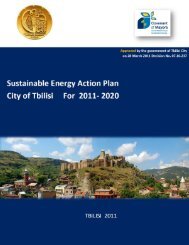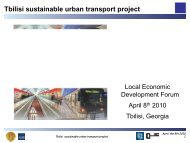LOCAL ECONOMIC DEVELOPMENT PLAN FOR TBILISI ... - LED
LOCAL ECONOMIC DEVELOPMENT PLAN FOR TBILISI ... - LED
LOCAL ECONOMIC DEVELOPMENT PLAN FOR TBILISI ... - LED
Create successful ePaper yourself
Turn your PDF publications into a flip-book with our unique Google optimized e-Paper software.
In order to turn the city facade to the river Mtkvari the arrangement of<br />
embankments and, in some places, cutting into the river Mtkvari with green areas was<br />
also planned.As for the “Old Tbilisi”, the “Socialistic Reconstruction” practically meant its<br />
elimination.<br />
It must be mentioned that implementation of the plan of 1934 was stopped by the<br />
beginning of World War II; but some fragments of this plan were soon realized – forest<br />
planting on Tiflis trench slopes; limitation of the Mtkvari bed in the concrete dams and the<br />
arrangement of the embankments; cultivation of new gardens and parks; solution of such<br />
important city planning knot as the Heroes’ Square, the construction of the Circus Hill, the<br />
arrangement of Cheluskinelebi (today the Tamar the Queen street) bridge and street, etc.<br />
After the war, basically, the already begun and planned constructions were continued –<br />
the second row of Governmental House, building of Tea Thrift Trust (today the<br />
Intercontinental hotel), building of Coal Industrial Trust on Zemeli, etc.<br />
“Khrushchev thaw” acquired a powerful impulse to the spatial development of<br />
Tbilisi in the second half of the 1950s. As a result of housing construction introduced in the<br />
peripheral zones, communal flats were partly eliminated; housing stock structure met the<br />
needs of the demographic structure (“one flat – one family”). New housing policy required<br />
assimilation of new space; as a result of considering land as an non-economic category<br />
the extensive forms of city development were introduced, basically by acquiring rural<br />
areas.<br />
Such tendency became significantly stronger under the conditions of developing<br />
The Third General Plan of Tbilisi. “The General Plan of Tbilisi Reconstruction and<br />
Development” was passed in 1970 and it fully reflected the ideology of a Soviet city<br />
planning dominating at that time. In this case among the components of the ideology<br />
several are essential:<br />
o Considering Tbilisi as self-content, autonomous settlement;<br />
o Principle of locked labor balance;<br />
o Neglecting the agglomeration (metropolitan area) realities;<br />
o Territorial expansion;<br />
o<br />
o<br />
Extensiveness of planning;<br />
Hard vertical subordination of territorial units in the settlement system (cityouter<br />
district (suburbs) zone), etc.<br />
As a result, planners were forced to think within the frame of expanded<br />
administrative boarders of Tbilisi. On the contrary to the linear nature of the capital, a form<br />
of “ring-shaped roll” around Tbilisi Water Reservoir, of spatial development was proposed<br />
in the new general plan. Such kind of priority naturally caused generation of new,<br />
latitudinal directions in the development of Tbilisi city center.<br />
Tbilisi center continued its linear development; its basic axis was again up to the<br />
river Mtkvari; the linear center was formed in the following configuration: Freedom Square<br />
– Rustaveli Avenue – Merab Kostava Street in two directions – with branches to Vake and<br />
Saburtalo and tied by means of newly built road of Vake-Saburtalo. Parallel growth of the<br />
city center was observed by passing David the Builder Prospect into Didube, Akaki<br />
Tsereteli Prospect.<br />
Simultaneously to this leading tendency of Tbilisi center the second, specific<br />
direction – returning certain functions to “Old Tbilisi” – is being gradually developed<br />
basically, in the way of reconstruction and adaptation of historically formed urban<br />
environment. This trend was conceived in the 70ies of the 20th century, when for the first<br />
time in Tbilisi conditions the State Defense Zone of the Old City (1975), was introduced<br />
which was developed later and acquired three part structure – State (strict) Defense Zone,<br />
Development Regulating Zone and Natural Landscape Protection Zone (1985).<br />
10
















